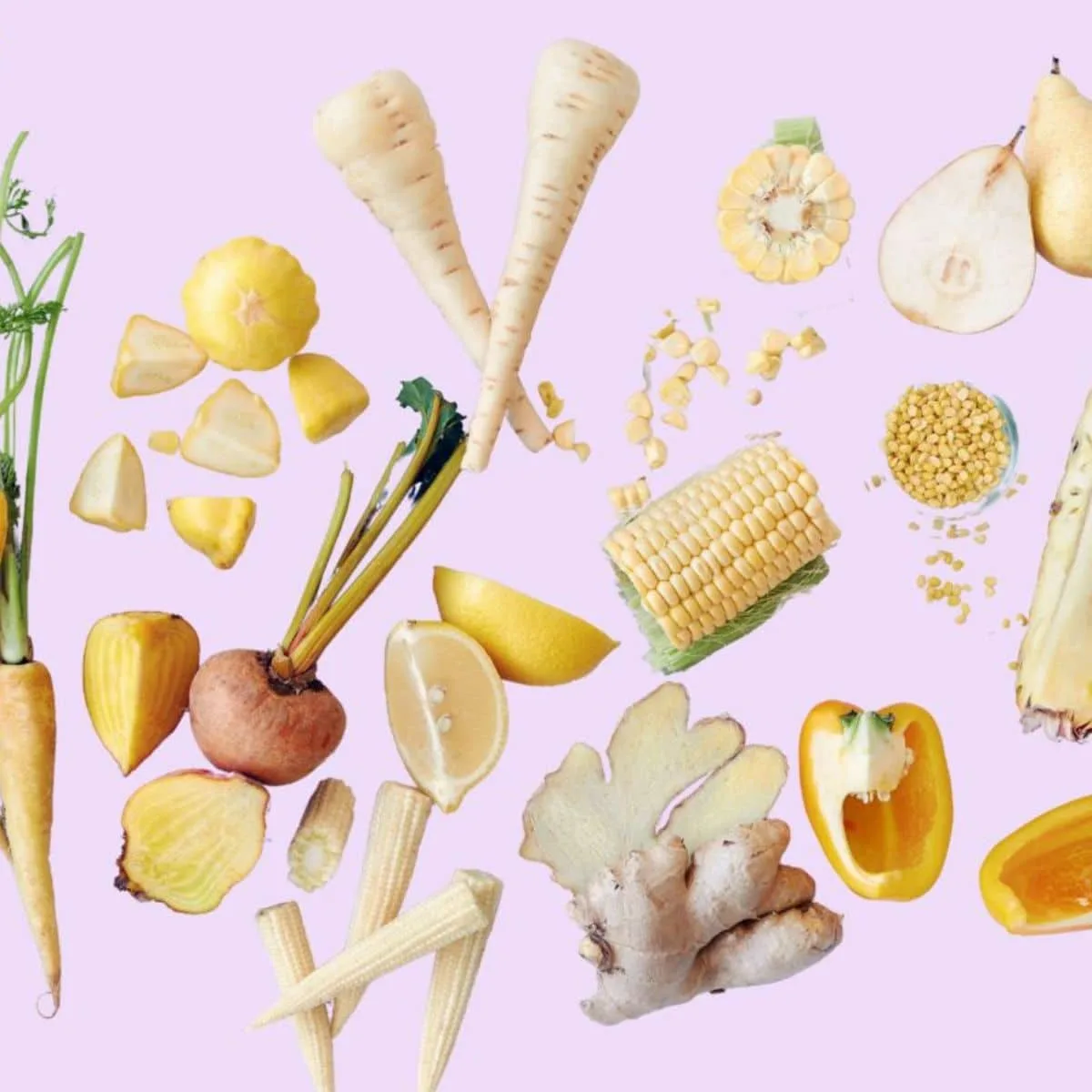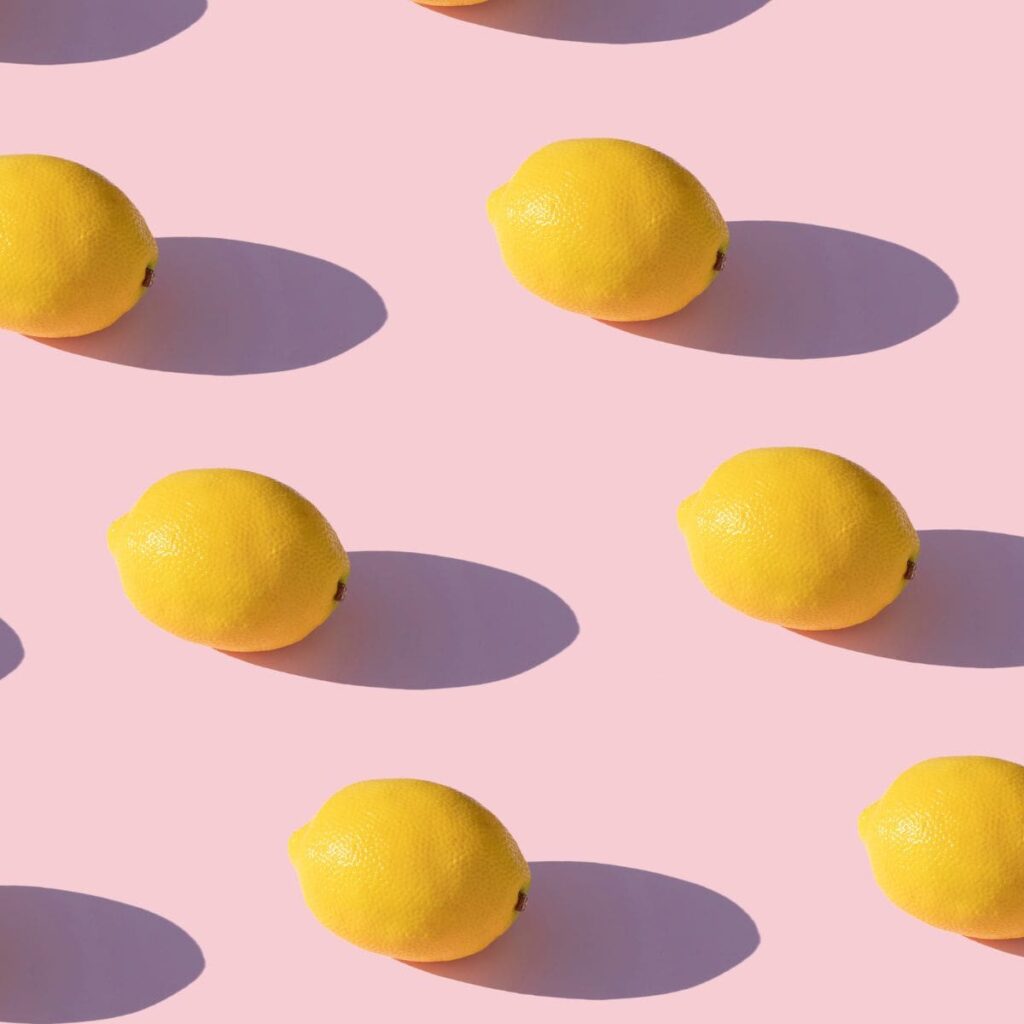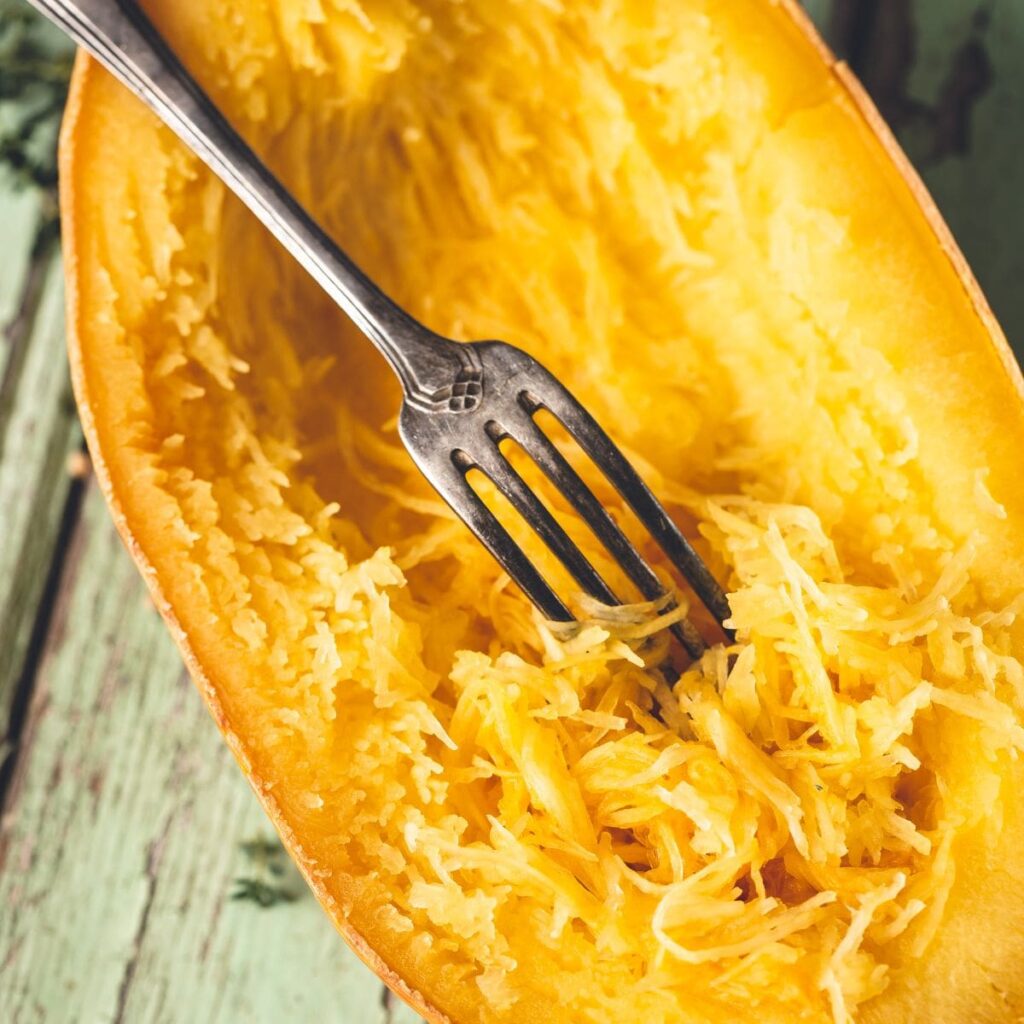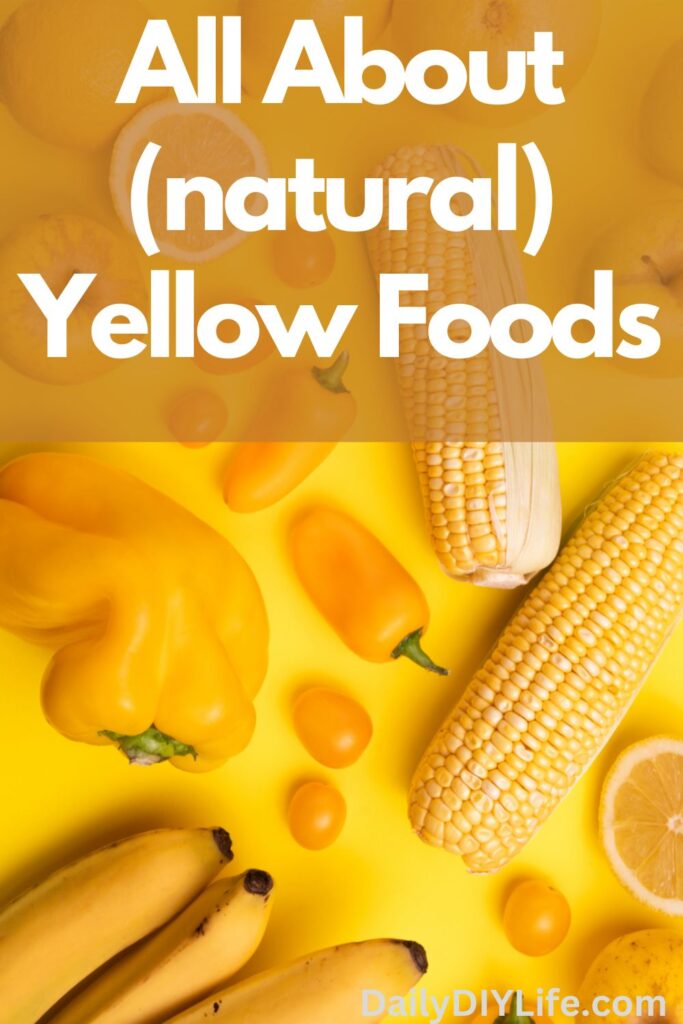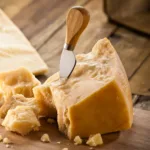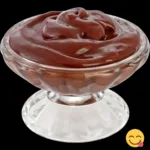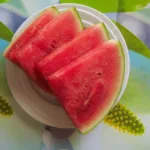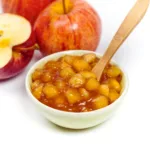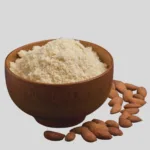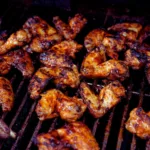Those of us that enjoy flavorful, aromatic cuisine can’t help but salivate when we think of yellow foods. We begin to daydream of hearty Spanish-style curried rice and chicken (Arroz con Pollo), or spicy lentil dal with curry (curried lentils).
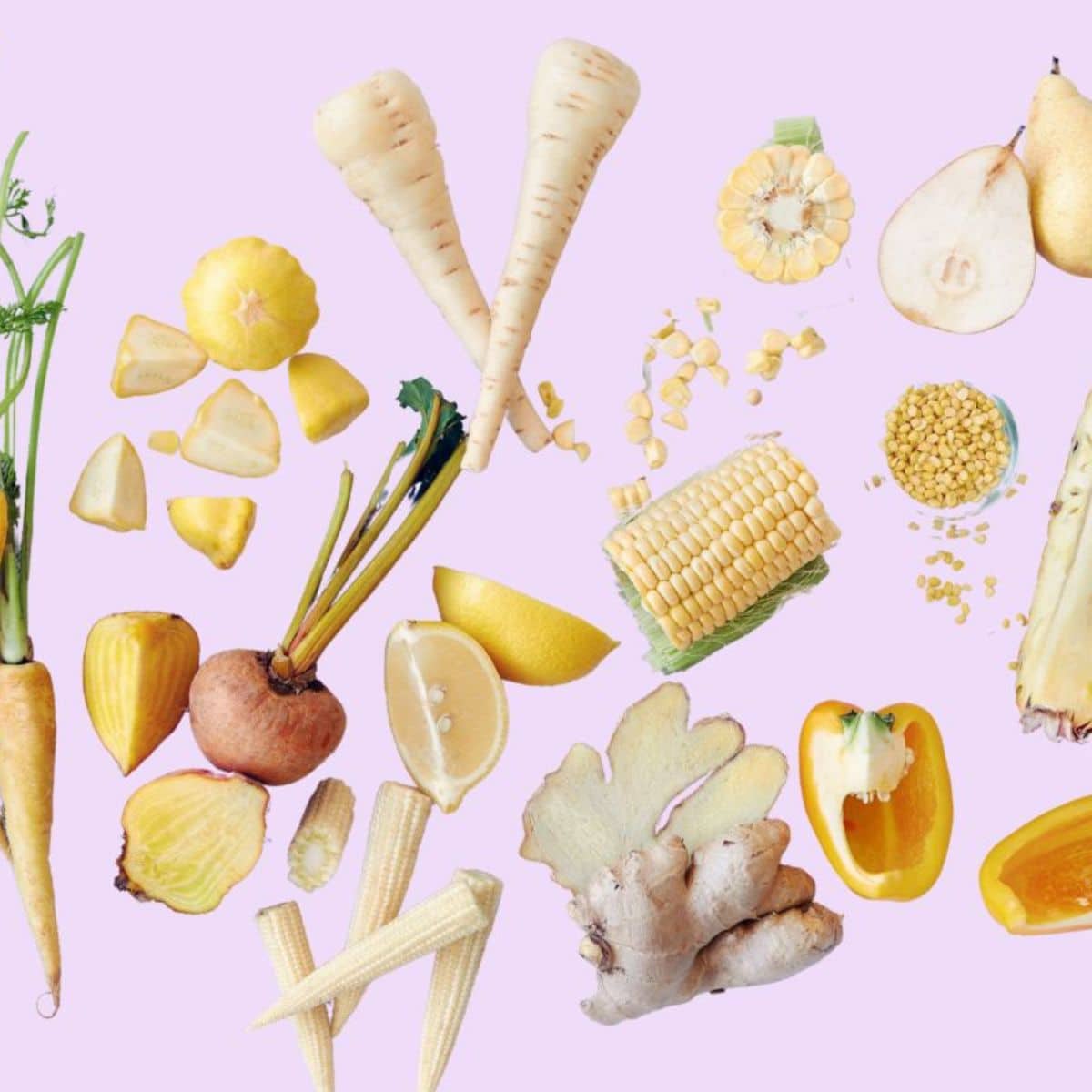
When it comes to yellow fruits and veggies, our brain links the color yellow to ripeness, and we feel reassured that our yellow produce is ready to eat. In fact, many of us tend to eat with our eyes first. We can all agree that adding yellow foods to a dish improves the visual presentation, as well as the flavor profile and nutritional content.
But what is it exactly about yellow foods that makes them an essential component of our daily diet? Let’s cover everything there is to know about yellow food and highlight a few recipes and snacks that we can include in our daily routine with ease.
Psst… Once you’ve learned all you need to know about yellow foods, check out our posts all about red foods, all about pink foods, all about blue foods, and all about orange food!
Why Are yellow Foods Yellow?
Carotenoids are fat-soluble pigments that are found in brightly colored fruits and vegetables. This includes yellow, orange, and red foods.
There are many types of carotenoids that contribute to pigment production in plants. However, xanthophylls in particular are what produce that naturally bright yellow pigment.
Xanthophylls are a form of oxygenated carotenoid that is typically found in vascular plants and algae. There are three primary forms of xanthophylls, namely zeaxanthin, lutein, and cryptoxanthin.
Xanthophylls absorb indigo and blue light to facilitate photosynthesis. They also protect the plant cells from the damage caused by excessive sunlight. Xanthophylls do this by dissipating the excess energy in the form of heat.
Yellow Foods (Fruits)
Yellow foods can come in all shapes and sizes, as well as have varying intensities of yellow color (some bright, others quite pale) and nutrients.
To make your life easier, we have identified the naturally yellow foods with the best attributes! Below we have listed the top 5 yellow fruits and vegetables that will brighten up your dishes and your day!
Lemons
Lemon is a hybrid between citrons and Seville oranges. This citrus fruit is well-known for its sour taste, and its naturally high vitamin C content. In fact, one cup of raw lemon juice contains more than 100% of our daily vitamin C requirements.
However, one lesser-known fact is that lemons are also high in potassium and vitamin B6.
Lemons are usually not eaten whole, but instead, the juice is used to add flavor to recipes for sauces, salads, cakes, smoothies, and the list goes on.
Pineapples
Pineapples are tropical fruits that have historically been found in South America. They have a tough, spiky exterior, but when peeled they reveal a soft, yellow, juicy, and sweet interior.
Most people are surprised to learn that pineapple is actually a type of berry. However, it is no secret that this delicious fruit gives us tons of health benefits.
One cup of raw pineapple chunks has more than 80% of our daily requirements for vitamin C and more than 60% of our daily requirements for manganese. Pineapples are also rich sources of copper, thiamine, folate, potassium, and magnesium.
Bananas
Bananas are one of the most widely consumed fruits in the world. This is because of its high availability and low costs, not to mention its sweet flavor and creamy texture. Amazingly enough, a banana is also a type of berry (this classification is based on the part of the tree which develops the fruit).
One cup of raw bananas has more than 40% of our daily value of vitamin B6, as well as more than 20% of our daily value of vitamin C, manganese, copper, and fiber. Bananas are also a great daily source of phosphorus.
Mangoes
A mango is a tropical fruit with a large seed in the middle, that is surrounded by edible flesh. When ripe, mangoes become sweet, soft, and succulent, with a bright yellow interior. The ripe fruit also has a strong, sweet aroma.
One cup of raw, sliced mango contains more than 60% of our daily vitamin C requirements. Mangoes are also great sources of vitamins B6, A, E, and K, as well as the mineral potassium.
Pears
Pear trees are native to Southeast Asia, and the ripe fruit is sweet and juicy in flavor. A pear is quite similar to an apple in that they are both pome fruit that has evolved from a common ancestor. There are many varieties of pear, but one of the most well-known varieties is the Asian pear, also known as the Japanese pear.
One cup of raw, sliced pear contains more than 15% of our daily requirements for dietary fiber and more than 10% of our daily copper requirements. Pears are also good sources of vitamins C and K, as well as the mineral potassium.
Yellow Foods (Vegetables)
Potatoes
The potato is a relative of the nightshade family and it was first cultivated in Peru from as far back as 6000 BCE. This root tuber comes in many varieties, with two of the most popular being Yukon gold potatoes and sweet potatoes.
Yukon gold potatoes have a mild flavor and a soft, creamy texture when cooked. One cup of cubed Yukon gold potatoes (with the skin on), contains more than 10% of our daily requirements of vitamins C and B6.
Sweet potatoes have a sweeter flavor than Yukon gold potatoes. They also have a soft, creamy texture when cooked, but are generally stringier than Yukon gold potatoes. One cup of sweet potatoes has more than 100% of our daily vitamin A requirements and more than 20% of our daily vitamin B5 and copper requirements.
Yellow Bell Pepper
Yellow bell peppers are simply green bell peppers that have been allowed to mature. During the ripening process, the green (unripe) bell pepper changes color to yellow, then orange, and then to red when it becomes fully ripe.
One large yellow bell pepper has almost 4 times your daily requirements for vitamin C.
Yellow peppers are also great sources of vitamins B6, B9, K1, E, and A, as well as the mineral potassium.
Yellow Squash and Butternut Squash
Yellow squash, also known as summer squash, is a member of the zucchini family and closely resembles the zucchini in shape and size. Yellow squash has a bright yellow exterior and a pale-yellow interior that becomes soft and slightly sweet when steamed. The texture and flavor are frequently compared to that of pumpkin.
Yellow squash also has a thin skin that is easy to peel and is also edible. One cup of raw, cubed yellow squash contains more than 20% of our daily vitamin C requirements. Yellow squash also contains plenty of folates, magnesium, iron, potassium, and fiber.
Butternut squash, also known as winter squash, grows much larger in size and has a very tough outer skin that is largely inedible. Butternut squash has a pale-yellow exterior and bright yellow flesh on the inside that also becomes soft and sweet when cooked.
Butternut squash is rich in vitamins A, C, E, B1, B3, B6, and folate, as well as magnesium, potassium, and manganese.
Jackfruit
The jackfruit is the largest known tree-bearing fruit and is a relative of the fig and breadfruit family. The external skin is thick, bumpy, and green in color, but when peeled, the interior is soft, yellow, and fleshy, with many stringy pods contained inside.
One cup of raw, sliced jackfruit contains more than 30% of our daily requirements for vitamin B6 and more than 20% of our daily requirements for vitamin C.
Jackfruits are a great source of plant-based protein and dietary fiber. They are also a good source of the minerals magnesium, potassium, copper, and manganese.
Corn
Corn, as we know it today, is derived from a primitive wild grass plant native to central Mexico called teosinte. Also referred to as maize, corn was domesticated over thousands of years to become one of the most important crops on the planet.
One cup of raw corn contains more than 10% of our daily requirement of amino acids. This includes histidine, isoleucine, leucine, threonine, valine, phenylalanine, and tyrosine. Corn is also a good source of potassium and magnesium.
(Naturally) Yellow Food Snacks
Who said that yellow snacks have to be boring? Being nutritious is a significant plus, but if it’s not delicious, why bother? Here are 3 naturally yellow snack categories we can enjoy without a guilty conscience. Below are some great ready-to-eat snacks that are naturally yellow (not a yellow number 5 food coloring in site!)
Cheese-Based Snacks
Fun fact, grass actually contains the carotenoid called beta-carotene, which is fat soluble. Beta-carotene accumulates and is stored in the milk fat of grass-fed cows. However, the milk itself appears white at first because the fat is initially concealed by protein clusters.
The pigment is released after the bacterial culture is added during the cheese-making phase, and the resulting cheese has a yellowish hue.
Dairy is a good source of calcium, vitamin D, potassium, and protein. Dairy products should be used in moderation for best results.
Just the Cheese Bars are a delicious snack that is low in calories, and can be enjoyed anywhere, anytime! If you are on the more conservative side, there’s nothing wrong with sticking to these wholesome Colby Jack Cheese Snack Sticks.
Fruit-Based Snacks
The problem with fruit snacks is that most of them are so high in added sugars that it overshadows any health benefits contained.
Luckily, we have found a range of natural, sugar-free, non-GMO fruit snacks that bridges the gap between taste and nutritional value. Among the best yellow snack options include the:
Dried Banana Chips and Fruit Snacks
If dried fruit isn’t your thing, fear not! Try this Dairy-Free Mango Sorbetto from Talenti. This ice cream is delicious on its own, but can also be added to smoothies or milkshakes for an extra lift. Good luck with portion control!
Yummy Yellow Food Recipes
Now that we have our yellow fruit, veggies, and snacks covered, let’s combine what we’ve learned to make some savory, yellow-inspired meals!
Crispy Air Fryer Polenta Truffle Fries
You will never look at French fries the same again! In this recipe, you will use either pre-cooked or quick cook polenta to make bite-sized wedges. The wedges are then fried in truffle-infused olive oil and enhanced with truffle salt.
This recipe is gluten-free, and polenta is a well-known healthy carb option.
Butternut Squash Soup
Nothing makes you feel more comforted, warm, and at peace than a steamy, creamy, delicious, and nutritious bowl of hearty soup. This recipe only requires a few ingredients and is quick and easy to prepare!
In fact, grab a bowl of pull-apart garlic bread as a side dish and you will simply be forced to put this recipe as your #1 favorite meal of all time.
Smoked Corn on the Cob (With or Without a Smoker)
Listen, you haven’t really tried corn unless you have had this insanely delicious smoked corn recipe. You only need to taste this delicious side dish once and it will be making a special appearance on your menu every week for the rest of the year!
Yellow Foods FAQs
What are foods that are yellow?
Here are some more yellow foods:
- Pineapple: A tropical fruit with a sweet, tangy flavor and vibrant yellow flesh.
- Lemons: A sour citrus fruit with a bright yellow rind and juice often used for flavoring in cooking and baking.
- Yellow squash: A type of summer squash with a mild flavor and yellow skin.
- Saffron: A spice derived from the crocus flower, known for its bright yellow color and unique flavor.
- Golden beets: A yellow variety of beetroot with a sweet, earthy flavor.
- Yellow tomatoes: A variety of tomato with a sunny yellow color and a mild, sweet taste.
- Yellow watermelon: A less common variety of watermelon with a yellow flesh and a sweet, refreshing flavor.
- Yellow lentils: A type of legume with a mild, nutty flavor and bright yellow color when split.
- Turmeric: A spice known for its vibrant yellow color and earthy, slightly bitter taste, often used in Indian cuisine.
- Egg yolks: Egg yolks, not the whole egg, are often a vibrant yellow. And if you want to learn more, here’s everything you need to know about eggs.
- Yellow mustard: Let’s not forget about condiments!
- Yellow plums: A type of plum with yellow skin and flesh, known for their sweet and tangy flavor.
- Yellow apples: Certain varieties of apples, such as Golden Delicious, have a yellow skin and a sweet, mild flavor.
- Yellow carrots: A less common variety of carrot with a yellow color and a sweet, slightly earthy taste.
- Yellow kiwi: A sweeter, less acidic variety of kiwifruit with a golden-yellow flesh.
- Yellow yams: A type of root vegetable with a yellow flesh and a starchy, slightly sweet flavor.
- Yellow cauliflower: A variety of cauliflower with a yellow hue, offering a similar taste and texture to white cauliflower.
- Yellow-fleshed potatoes: Certain varieties of potatoes, such as Yukon Gold, have a golden-yellow flesh and a buttery flavor.
- Yellow raspberries: A less common variety of raspberry with a golden-yellow color and a sweet, delicate flavor.
What snack is yellow?
- Banana chips: Thinly sliced bananas that are dried or fried, creating a sweet, crispy snack.
- Popcorn: Yellow corn kernels that are popped, creating a light, airy snack. Plain popcorn can have a natural yellow hue, but movie theater popcorn often gets its bright yellow color from added butter flavoring.
- Cheese-flavored crackers: Processed crackers that are seasoned with cheese powder, giving them a yellow color and a savory taste.
- Corn chips: Crunchy snack chips made from cornmeal and often seasoned with salt, providing a yellow appearance and a satisfying crunch.
- Yellow vegetable chips: Chips made from yellow vegetables such as yellow beets, yellow squash, or yellow carrots, which are thinly sliced and fried or baked until crispy.
- Lemon-flavored cookies: Yellow-colored cookies that are flavored with lemon juice or zest, providing a sweet and tangy taste. Check out our list of summer cookies.
- Cheese puffs: Puffed corn snacks coated with cheese powder, giving them a bright yellow color and a cheesy taste.
- Yellow-colored gummy candies: Chewy candies made with yellow food coloring and flavored with fruit extracts or artificial flavors like lemon, pineapple, or banana.
- Yellow rice cakes: Light, crispy rice cakes made from puffed rice, which can have a natural yellow hue.
- Yellow—or cheese—flavored popcorn: Popcorn that is coated with yellow-colored cheese or butter flavoring, adding a savory taste to the snack.
What food is yellow for a color party?
- Corn and yellow bell pepper fritters: Mix corn kernels, diced yellow bell peppers, flour, eggs, and seasonings to create a flavorful batter. Fry spoonfuls of the batter until golden and crispy for a delicious appetizer.
- pineapple salsa: Combine fresh, diced mangoes and pineapples with red onions, jalapeños, cilantro, and lime juice for a vibrant, yellow-colored salsa that’s perfect for dipping or topping grilled chicken or fish.
- Yellow gazpacho: Blend yellow tomatoes, yellow bell peppers, cucumbers, and onions with seasonings and chilled vegetable stock to create a refreshing, cold soup that’s perfect for a summer gathering.
- Curried deviled eggs: Prepare deviled eggs with a twist by adding curry powder and turmeric to the yolk mixture, giving the filling a vibrant yellow color and a unique, spicy flavor.
- Lemon and saffron risotto: Cook Arborio rice with saffron, lemon juice, and zest, white wine, and vegetable broth to create a creamy, bright yellow risotto that’s bursting with flavor.
- Yellow beet hummus: Blend roasted yellow beets with chickpeas, tahini, garlic, lemon juice, and olive oil for a colorful and delicious twist on traditional hummus.
- Polenta squares with yellow tomato bruschetta: Prepare firm polenta and cut it into squares, then top with a mixture of chopped yellow tomatoes, fresh basil, and garlic for a creative take on bruschetta.
- Pineapple and yellow watermelon skewers: Thread alternating pieces of pineapple and yellow watermelon onto skewers for a visually appealing and refreshing fruit snack.
- Turmeric and coconut milk panna cotta: Prepare a yellow-colored panna cotta by infusing it with turmeric and using coconut milk for a tropical twist. Serve chilled with a drizzle of honey or agave syrup.
- Mini lemon meringue pies: Bake or buy mini lemon meringue pies, with their bright yellow lemon curd filling and fluffy, toasted meringue topping, as a sweet treat for your guests.
Why are some foods yellow?
Whether they start out yellow or become yellow, there are a few different reasons why some foods take on this specific color or hue:
- Artificial food colorings: Some processed foods get their yellow color from artificial colorings. These colorings are typically added to make the food more visually appealing or to enhance the appearance of a natural color that may fade during processing or cooking. Examples of yellow food colorings include Yellow 5 (tartrazine) and Yellow 6 (sunset yellow).
- Natural pigments: Certain compounds in foods are responsible for their yellow color. For example, carotenoids such as beta-carotene, lutein, and zeaxanthin are responsible for the yellow to orange hues in foods like carrots, sweet potatoes, corn, and egg yolks. Curcumin, the active ingredient in turmeric, gives the spice its vibrant yellow color.
- Maillard reaction: The Maillard reaction is a chemical process that occurs during cooking when proteins and sugars interact under heat. This reaction can cause foods to turn yellow or brown, depending on the specific compounds involved and the cooking time and temperature. Examples of foods that develop a yellow color due to the Maillard reaction include bread crusts, toasted marshmallows, and seared meats.
- Chlorophyll breakdown: In some cases, the yellow color in foods is revealed when the green chlorophyll pigment breaks down during ripening or cooking. This process exposes the underlying yellow pigments, such as carotenoids. An example of this is the yellowing of green bell peppers as they ripen.
Have questions or suggestions about what you’ve learned about yellow foods? Leave them in the comments below. And if you like posts like this, you’ll love our list of foods that start with the letter “E” and our post about blue fruits.

